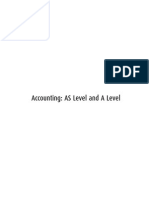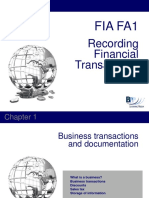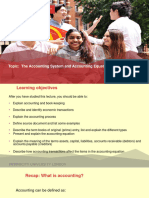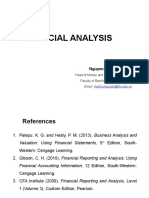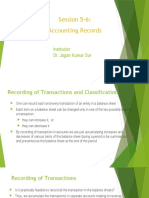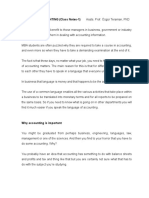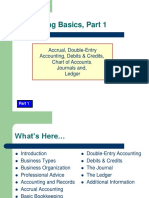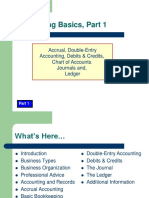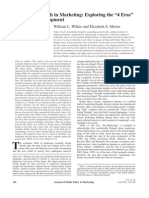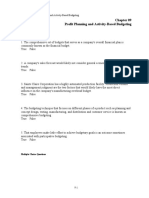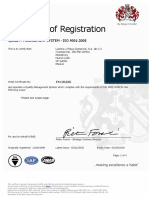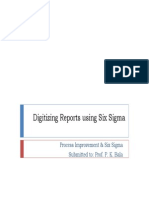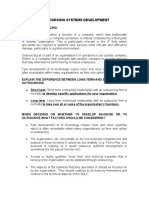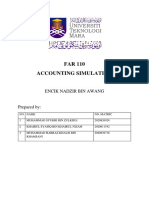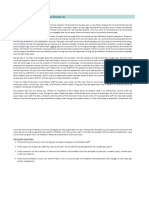Accounting Fundamentals (BUS3701) Lecture 1
LECTURE 1
Lesson Title: Introduction to Accounting Concepts and Basic Book-keeping
Procedures
Lesson Intended Learning Outcomes
On completion of the lesson, students are expected to be able to:
1. Define “accounting” and “book-keeping”.
2. Understand the meanings of “assets”, “liabilities” and “capital”.
3. Understand the accounting equation.
4. Recognize the effects of business transactions on the accounting equation.
5. Explain the principles of double entry system.
6. Use the ledger accounts to record business transactions.
Page 1
�Accounting Fundamentals (BUS3701) Lecture 1
1. Define “accounting” and “book-keeping”
Accounting is a system (process) that measures the activities of an entity in
monetary terms. It involves the following stages:
(a) Recording data
(b) Classifying and summarizing data
(c) Communicating information
(d) Interpreting and analyzing information
Book-keeping is the art of recording, classifying and summarizing the transaction
of an entity so as to provide summary information to the management on a
periodic basis.
It is concerned largely with procedural matters, and the development and
maintenance of accounting records.
2. Assets, Liabilities and Capital
Assets:
Resources owned by the business. Examples include buildings, machinery,
inventory, motor vehicles, trade receivables (debtors), cash, and money in the
bank.
Liabilities:
Debts owed by the entity to outside parties, eg, trade payables (creditors), loan,
bank overdraft.
Capital:
Resources supplied by the owner(s). It includes:
(a) fund and assets contributed by owners; and
(b) profit retained.
It is also called the owner’s equity or net worth.
Page 2
�Accounting Fundamentals (BUS3701) Lecture 1
3. Accounting Equation
Financial accounting is based upon a simple idea, “the accounting equation”:
(a) When an entity starts up, it needs resources. Initially they are supplied by
the owner:
i.e. Resources in the entity = Resources supplied by the owner
(b) In accounting terms, they are represented as:
Assets = Capital
(c) If further resources are supplied by others, the equation becomes:
Assets = Capital + Liabilities
4. Accounting Equation - Examples
Resources in the business = Resources supplied by the owner
When a person starts business with $100,000 cash and $150,000 inventory, he
has:
Assets = Cash + Inventory
= $100,000 + $150,000
= $250,000
Capital = $250,000
i.e. Assets = Capital
Then, he buys a computer at $5,000 and agrees to pay the supplier later.
Assets = Cash + Inventory + Computer
= $100,000 + $150,000 + $5,000
= $255,000
Capital = $250,000
Liabilities = $5,000
i.e. Assets = Capital + Liabilities
Note: Both sides of the equation always are of the same totals.
Resources: what they are = Resources: who supplied them
i.e. Assets = Capital + Liabilities
Page 3
�Accounting Fundamentals (BUS3701) Lecture 1
4.1 Examples 1:
Examples of Transaction Effect
Assets Capital Liabilities
1. Buy goods on credit. Increase Increase
(inventory) (trade payable)
2. Buy goods by cheque Increase
(inventory)
Decrease
(bank)
3. Pay the supplier by cheque Decrease Decrease
(bank) (trade payable)
4. Owner pays more capital Increase Increase
into the bank. (bank) (capital)
5. Owner takes money out of Decrease Decrease
the business bank account (bank) (drawings)
for his own use.
4.2 Example 2
Example of transaction Effect
Assets Capital Liabilities
A. The owner, Jimmy Yau Increase Increase
started a business with (Cash) (Capital)
cash $150,000.
B. Bought office furniture Increase
$35,000 by cash. (office furniture)
Decrease
(cash)
C. Bought computer $8,000 Increase Increase
on credit. (Computer) (Trade payable)
D. Jimmy Yau borrowed Increase Increase
$250,000 from Bank of (Bank) (Bank loan)
China.
E. Jimmy Yau took $5,000 out of Decrease Decrease
the business bank account
(Bank) (Drawings)
for his private use.
Page 4
�Accounting Fundamentals (BUS3701) Lecture 1
Textbook examples
Refer to Frank Wood’s Business Accounting 1
Illustrative Example on P.15
“Review Questions” 1.11 and 1.12A on P.19
Example of a Statement of Financial Position (or Balance Sheet)
Bonnie Yam
Statement of Financial Position as at 31 May 2017
Non-current assets $ $
Motor car 132,000
Current assets
Inventory 16,000
Trade receivable 400
Cash at bank 25,600
42,000
Total assets 174,000
Financed by:
Capital 170,000
Current liabilities
Trade payable 4,000
Total capital and liabilities 174,000
Tutorial Exercises
Frank Wood’s Business Accounting 1
(A) Review Questions, p.17, 1.1, p.18, 1.2A, 1.4A
(B) Review Questions: P.18, Question 1.8A, 1.10A on p.19, Question 1.14 A
Page 5
�Accounting Fundamentals (BUS3701) Lecture 1
5. Double Entry System
5.1 Double Entry System
It has been seen that each transaction affects two items – one will receive value,
and the other will give value.
To show the full effect of each transaction, both aspects of receiving value and
giving value for every business transaction must be recorded.
That means:
a debit entry/entries to one or more accounts and
a corresponding credit entry/entries to one or more accounts
5.2 The Accounts for Double Entry
Ledgers and Ledgers Accounts
A ledger account (or an account or “T”-account) – an individual record in a
summarized form of all the business transactions that have taken place.
Title of Account
Date Details $ Date Details $
Debit Side (Dr) Credit Side (Cr)
A ledger – an accounting record which keeps the entire group of ledger
accounts.
The left-hand side of each account is called the debit side, while the
right-hand side is called the credit side. The title of each account is written
across the top of the account at the centre.
5.3 Basic Principles of Double Entry
This simply means every transaction is entered twice in different accounts
affected – i.e. DOUBLE.
Therefore, each transaction involves at least TWO entries in the accounts:
ONCE on the DEBIT side and
ONCE on the CREDIT side
Every debit entry in one account must have a corresponding credit in
another account and vice versa.
Page 6
�Accounting Fundamentals (BUS3701) Lecture 1
6. Recording Assets and Liabilities
Accounts To record Entry in the Account
Assets Increase Debit
Decrease Credit
Liabilities Increase Credit
Decrease Debit
Capital Increase Credit
Decrease Debit
7. Recording Income and Expenses
In addition, an entity must have accounts for its income and expenses.
Accounts To record Entry in the Account
Income Increase Credit
Decrease Debit
Expenses Increase Debit
Decrease Credit
Summary
Title of Account
Date Details $ Date Details $
Debit Side (Dr) Credit Side (Cr)
To increase: To increase:
Assets Capital, Liabilities
Expenses Income
Page 7
�Accounting Fundamentals (BUS3701) Lecture 1
Action of Transactions Examples
The journal entries are:
1. Rent of $2000 is paid in cash on 2 July 2017.
Nature of the transaction:
DR: Rent $2,000
CR: Cash $2,000
2. Motor expenses are paid by cheque $355 on 17 July 2017.
Nature of the transaction:
DR: Motor expenses $355
CR: Bank $355
3. $60 cash is received for commission earned by the firm on 20 Jul 2017.
Nature of the transaction:
DR: Cash $60
CR: Commission received $60
Post to the ledger accounts:
Rent
2017
2 Jul Cash $2,000
Cash
2017 2017
20 Jul Commission received $60 2 Jul Rent $2,000
Motor Expenses
2017
17 Jul Bank $355
Bank
2017
17 Jul Motor expenses $355
Commission received
2017
20 Jul Cash $60
Page 8
�Accounting Fundamentals (BUS3701) Lecture 1
8. Book-keeping Procedures – Demonstration
Transactions Effect Journal Entries
2017 Started a retail business Increase: Bank Dr. Bank $150,000
Aug 1 investing $150,000 into a Increase: Capital Cr. Capital $150,000
business bank account.
Aug 3 Bought goods on credit Increase: Inventory Dr. Purchase $30,000
from AA Machines Increase: Trade Payable: Cr. TP: AA Machines
Company $30,000. AA Machines Company Company $30,000
Aug 4 Withdrew $30,000 cash
from the bank and placed
it in the cash box.
Aug 7 Bought a motor van
paying $24,000 in cash.
Aug 10 Sold goods for $8,500 on
credit to Mary Li.
Aug 21 Returned goods, value
$15,000, to AA Machines
Company.
Aug 28 Received a cheque for
$1,500 from Mary Li.
Aug 30 Bought another motor
van by paying a cheque
of $36,000.
Aug 30 Paid the amount of
$10,000
to AA Machines
Company by cheque.
Post the above transaction into the ledger accounts below:
Bank
Page 9
�Accounting Fundamentals (BUS3701) Lecture 1
Capital
Purchases
Trade Payable - AA Machines Company
Cash
Motor Van
Trade Receivable – Mary Li
Sales
Returns outwards
Worked examples: 2.4 P.24-28
Exercises:
Ex. 2.1, 2.2A – P. 31
Ex 2.5A – P. 32
Reading References
Frank Wood's Business Accounting 1 - Chapter 1 and 2.
Page 10





